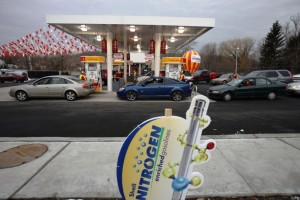
Gas prices are expected to continue falling for some time as Saudi Arabia is unlikely to cut production.
With the Labor Day holiday looming, the price of oil continues to bounce around on global markets.
However, the price of gasoline continued to drop across the country and most drivers should find themselves paying the lowest Labor Day weekend gas prices since 2004. The national average price for regular unleaded gasoline has fallen for 14 consecutive days for a total of 20 cents per gallon, according to AAA.
Market fundamentals remain bearish, even as oil prices staged a rally late last week that pushed prices a bit higher compared to early-week trading sessions where both Brent and WTI exceeded multi-year lows.
China’s economic health and the potential for Iranian oil to return to markets remain front of mind, and when combined with the expectation that Saudi Arabia is likely to continue production without limits, despite OPEC’s call to rein in production, in an attempt to drive weaker producers out of the market, it seems likely to keep downward pressure on global crude oil prices.
The average price of $2.47 per gallon marks a savings of 12 cents per gallon compared to one week ago and 18 cents per gallon versus one month ago, AAA reported this week.
Drivers nationwide continue to benefit from the relatively low price of crude oil with today’s average about 96 cents per gallon less than a year ago.
(Less than perfect: Consumer Reports’ worst four vehicles. For more, Click Here.)
Despite the persistence of some regional refinery issues, average U.S. gas prices are falling at the fastest rates since December. BP repaired problems at a refinery in Whiting, Indiana, which had sent prices markedly higher in the Midwest during August.
The Whiting refinery has resumed production and prices have fallen week-over-week in Michigan, Ohio, Indiana and Illinois. The East Coast is currently facing its own production challenges with reports that the Phillips 66 Bayway refinery in New Jersey is operating at reduced rates. This is in addition to PBF Energy’s Delaware City refinery shutting down its fluid catalytic cracking unit last week due to a fire. These East Coast issues have yet to significantly impact prices in the region as supply continues to outpace demand.
(Click Here for more details about FCA building a Jeep pickup truck.)
The Pacific Northwest remains the nation’s most expensive region for retail gasoline, and all of the states represented in the nation’s top 10 most expensive are located west of the Rockies. Alaska, at $3.40 per gallon, is the nation’s most expensive market for retail gasoline, unseating California at $3.35 per gallon after seven straight weeks as the market leader. Nevada at $3.13 per gallon, Hawaii at $3.10 per gallon and Washington at $2.95 per gallon round out the top five most expensive markets. On the other end of the spectrum, motorists in South Carolina at $2.02 per gallon are paying the lowest price at the pump in the nation.
The average price of gasoline has dropped a dime or more per gallon in 39 states and Washington, D.C. in the past month, according to AAA, and the price is discounted by a quarter or more per gallon in nine states month-over-month. The largest savings over this same period are in California where the price of gasoline has dropped by 41 cents, New Jersey where prices declined by 28 cents, Rhode Island where prices dropped by 27 cents and Maine where prices declined by 26 cents per gallon. Prices moved higher versus one month ago in Indiana, Illinois and Ohio.
(To see why the Takata recall is likely to be lower than expected, Click Here.)
Significant savings continue to be seen in yearly price comparisons due to the relatively low cost of crude oil, which set new multi-year lows last week before rallying to end the week. The price of gas is down year-over-year in every state and Washington D.C., and pump prices are discounted by $1 per gallon or more in 25 states. The largest yearly discounts are in Hawaii ($1.18), Vermont ($1.15) and South Carolina ($1.15).
